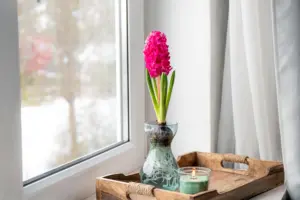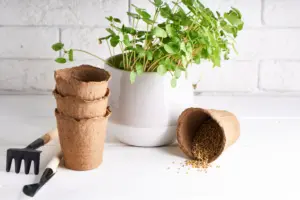
As you’re creating your terrarium you find yourself asked to put moss under the soil. Yes under. As a beginner in this area of indoor gardening and terrarium creation you wonder whether the instructions are quite right, so you find some more, that say exactly the same thing. Then you end up wondering why on earth do you need to put moss under the soil in a terrarium?
You may think moss is part of the decorative process of creating a terrarium, but its actually a very interesting plant that helps the ecosystem you are creating in your container flourish. Remember, the ecosystem you create in your terrarium for your mini indoor garden does not have drainage like a garden outside. And it is for this reason that moss is helpful in protecting your plants from overwatering. Let’s start to answer this question by looking at how drainage works in a terrarium, then what moss is and some key characteristics.
How do terrariums drain water?
Terrariums do not drain water. Unlike plants that grow in pots with drainage holes, terrarium plants don’t have anywhere for excess water to go as you use a glass container. Because water cannot escape, and it’s actually needed for your ecosystem to work, especially in a closed terrarium you build up layers before planting.
The layers work to drain water so your plants don’t get over saturated. Without any drainage water would build up at the bottom of your terrarium causing the soil to become too wet. This would lead to root rot in your plants, which is basically a death sentence.
This is where moss comes in to save the day. Placing moss as a third layer between the soil and drainage layer and charcoal serves a few key purposes that help manage moisture and keep your plants from getting too soggy.
What is moss?
Moss is a species of plant that has thousands of varieties and sub species to choose from. It is a delicate yet versatile plant that you can find in places all over the world. Thriving in humid environments, that’s why it does so well in terrariums, moss is a plant that no only looks interesting, it plays a huge role in plant ecosystems, especially in terrariums.
Did you know that moss does not have a traditional root system, it’s got something called rhizoids. This is sort of a root system but it’s function isn’t to feed the moss, it’s to anchor it in place. What makes moss such a great plant is that it gets it’s moisture from the air, not just rain. And this is the reason it doesn’t have that traditional dense root system like other plants.
As moss takes in all moisture it is perfect for the ecosystem in your terrarium in many ways. This forms part of the reasoning why you put moss under the soil in a terrarium.
5 Reasons why you put moss under the soil in a terrarium
There are 5 main reasons why moss is placed under the soil in a terrarium, and a lot of it has to do with the amazing abilities of this indoor and outdoor plant.
1. Moss Acts as a Natural Filter
One of the main reasons you add moss under the soil is because it works as a natural filter between the soil and the drainage layer. If you just think about soil and how it fills up spaces with its particles without a natural filter layer it would slowly sink into the gravel and clog up the drainage layer. Over time this creates nowhere for the water to escape to, and you end up with water trapped in the bottom of your terrarium.
By placing moss between these two layers, you create a barrier that holds the soil in place. This helps the drainage layer to do its job of keeping excess water away from your plant roots as the moss prevents the soil from seeping into the gravel. This is key to keeping your drainage system working.
2. Moss Prevents Water Build-Up
Placing moss between your charcoal layer and your soil layer helps to keep your plant roots safe in the terrarium. Moss is a plant that is a bit like a sponge, and it is excellent at absorbing excess moisture. This means when water passes through your soil it doesn’t end up pooling in the bottom of your container around your plant roots, it is absorbed by the moss. As long as you don’t go crazy and overwater your terrarium. Even moss has it’s absorption limits.
Moss absorbs, stores and release water back into your terrarium, while keeping your plant root systems safe from root rot, which happens to roots left in standing water that has nowhere to drain to.
Here is an explanation of how the moss layer under the soil works in a closed terrarium to prevent water build-up. Water from the soil will eventually seep down to the bottom. When this happens, the moss layer absorbs and holds onto that extra water instead of letting it pool. Because the moss absorbs excess moisture, it helps prevent the soil from becoming waterlogged.
3. It Helps Regulate Humidity Levels
If you’ve got a closed terrarium, the moisture that evaporates from the soil, plants, and moss stays trapped inside the container. Over time, this can create a super humid environment. Moss, with its ability to absorb and release moisture, helps regulate the humidity in your terrarium.
In other words, the moss holds onto moisture when there’s too much and slowly releases it when things start to dry out. It acts like a humidity control system inside your terrarium.
4. Prevents Root Rot by Managing Water Distribution
One of the biggest threats to terrarium plants, especially in closed terrariums, is root rot. This happens when plants sit in waterlogged soil for too long. The roots can’t get enough oxygen, and they start to decay. Once that process starts, it’s pretty much game over for your plants.
By putting moss under the soil, you create a buffer that helps distribute water more evenly. Excess water gets absorbed by the moss so your plants can stay healthy without their root system drowning. The water stored in the moss is released slowly back into the soil as needed as part of the water cycle, so it acts like a natural watering system.
5. Keeps Soil Structure Intact
Terrariums don’t have the luxury of being as flexible as outdoor gardens or even larger indoor planters. Since everything is contained, your soil structure matters a lot. Over time, soil can compact, especially in humid environments like closed terrariums. Compact soil isn’t great for root health because it makes it harder for oxygen, water, and nutrients to circulate and for your plants to absorb them.
Moss acts like a cushion beneath the soil, helping to keep your soil from compacting too much. It creates a layer that stays springy and light, which in turn keeps the soil more aerated. This is important because plants need oxygen at root level to grow properly. If they don’t get enough your plants will not thrive in your terrarium.
How to add the moss layer?
Take a look at our guide on how to create your own terrarium for all the steps you need to create your own DIY terrarium. When it comes to adding the moss layer, which is step three in our guide, you need to remember that moss is delicate. Because of its root system it will effectively cling to the gravel layer.
The best way to help the rhizoids attach is to gently press them into place. We find using the tips of a pair of tweezers helpful, particularly if it’s difficult to reach to the bottom of your terrarium. Be gentle and do not pierce the leaves, use your tweezers to guide your moss into place.
Best type of moss to use for the moss layer
Although there are over 1,200 species of moss to choose from, some of the most common species of moss to use under the soil in your terrarium include:
1: Sphagnum moss
This is the best moss to use for a bass layer as other moss often grows on top of this type of moss in the garden. It’s versatile and will provide the best option for your moss layer.
2: Hypnum
Often called ‘sheet moss’ or ‘carpet moss’, this moss offers blanket covering and will provide a great covering layer between your soil, activated charcoal and gravel.
3: Taxiphyllum Barbieri also known as Java moss
This moss will cling to the side of your substrate well and thrives well in moist and wet environments.

Why You Can’t Skip the Moss Layer
Here’s the bottom line: skipping the moss layer can lead to a selection of problems down the road that can impact the overall health, and success of your terrarium. Whether you have an open terrarium or a closed terrarium, without the moss layer you risk:
- Clogging your drainage layer with soil particles.
- Creating a waterlogged environment where your plants can’t thrive.
- Letting the humidity get out of control in a closed terrarium.
- Compacted soil, which makes it tough for roots to grow.
- Root rot setting in due to excess water building up inside your terrarium.
It might seem like an extra step when you’re setting up your terrarium, but trust me, it’s a step you don’t want to miss. It’s inexpensive, even if you are creating your terrarium on a budget and it is included in most terrarium kits. If it isn’t included in your kit, don’t make the rookie mistake of not adding moss. Instead find some sphagnum moss or sheet moss online and give your terrarium the best chance of thriving by putting moss under the soil in your terrarium. If you have any left over, you can even add it as a decorative feature with your other plants.
Won’t Moss Decay Under Soil?
Yes, over time it will decay and this will add nutrients to the soil. It actually helps to create a more natural ecosystem in your terrarium as if you think of a forest floor with moss, there are often other plants growing on top. The moss you put in between the soil and substrate is not there just to add visual appeal to your terrarium. It has a purpose as listed above.
When it decays you won’t smell it (the activated charcoal layer helps with this), harm your plants or negatively affect your terrarium, it is a natural part of the ecosystem you actually want to create inside your glass container.
Final Thoughts
So, there you have it, the reason why you put moss under the soil in a terrarium isn’t to add a decorative touch; it’s an essential part of creating a healthy, balanced mini-ecosystem. It helps filter water, regulates moisture, keeps the soil structure intact, and prevents root rot. If you’re setting up a terrarium and want it to thrive, don’t skip this step.









